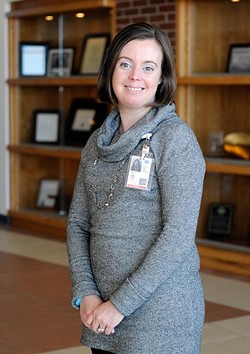
Bill Rice wanted to change.
He weighed 242 pounds and had a 46-inch waist; however, his motivation for living a healthy life came from losing a younger sister to diabetes, the country’s seventh-leading cause of death.
He called the Oklahoma City-County Health Department (OCCHD) and enrolled in its Total Wellness course. With the aid of health department dietitians and the support of his wife, Rice chose healthy food and became more active.
Six years after attending his first class, Rice weighs between 170 and 175 pounds, but more importantly, he overcame unhealthy behaviors. He said the free health and wellness program saved his life. Now, Rice volunteers with the course. He encourages others to follow the advice of the health department staff and not give up.
“It was all kinds of things,” Rice said of the different guidance shared by program dietitians. “Eat more fruits and vegetables. Drink more water. Exercise at least a half-hour a day. What clicked more than anything else was filling out that food diary. I absolutely hated doing that.”
With each course, instructors set a class goal for every participant to lose 5 percent of their body weight. Additionally, students set individual goals, like drinking more water, nixing snacking between meals, cutting back on sugar or developing exercise routines. Dietitians hold them responsible by reviewing food diaries and exercise plans.
“It was all very positive feedback,” Rice said, and he gave an example. “They would write, ‘make wiser choices,’ if you wrote down you ate eight candy bars for lunch.”

Diabetes, heart disease
Rice is not the first Total Wellness success story and will not be the last, said Jennifer Like, an OCCHD dietitian. The organization first offered the Total Wellness courses in 2007.
Last year, 1,200 people participated, shedding a combined total of 5,600 pounds.
“Just by losing a few pounds, you can have a big impact in your risk of diabetes and heart disease,” Like said. “It’s not something that has to change your entire life. You just have to do a little bit better, but you’ve made a significant impact on your health.”
OCCHD is one of many health agencies educating and promoting healthy lifestyles in the state. It’s no easy feat, as Oklahoma consistently ranks toward the bottom nationally in key health status indicators, including diabetes and heart disease. In December, The Commonwealth Fund, a private foundation that promotes better health care practices and supports independent research of health care issues, ranked Oklahoma next to last in a national health report. Only Mississippi ranked lower in the study examining 42 health indicators.
Specifically, the Sooner state ranked No. 48 in healthy lives, which looked at preventable premature deaths. Rates of diabetes and hypertension, or high blood pressure, were examined.
The Total Wellness course serves as a prevention tool and is offered at seven to 10 locations across Oklahoma County every four months. One is taught in Spanish. Each draws 40 to 50 participants, and Like said it’s not uncommon for the health department to create a waiting list due to high demand.
Over eight weeks, Total Wellness participants learn about a “picture-perfect meal,” how to eat healthy when dining out, physical activity and developing the right state of mind to change unhealthy behavior. The program follows guidelines established by the American Diabetes Association and American Heart Association.
While the information presented is accessible through a number of health books and websites, the course holds students accountable and classmates develop a support system to help each other. Many meet after class for 30-minute walks.
“You realize you are not in the struggle alone,” Like said. “Everyone in the room is doing the same thing. Hearing what others are doing makes it more attainable.”
Two-pronged approach
For those with documented heart disease, OCCHD offers a two-pronged approach to improving health. Participants enroll in Total Wellness but could also qualify for the My Heart program.
Aundria Goree, OCCHD community health administrator, said the two-year-old program helps county residents who are already at risk significantly lower their risk of cardiovascular disease. Participants report lower blood glucose and cholesterol levels after completing the program, offered through a partnership with OU Physicians and North Rock Pharmacy.
Often, OU Physicians staff will refer clients to My Heart. Few residents come forward asking about the program. Goree believes many in the community — especially those without health insurance or who don’t visit a primary care doctor — are not aware of their risk. Many Oklahomans have heart disease, which is the leading cause of death in the state, according to the Oklahoma State Department of Health.
“It’s the silent killer,” Goree said about heart disease, which is the term for all diseases and conditions that affect the heart. “You really don’t know you have it unless you’re screened.”
Typically, there are no symptoms with high blood pressure or high cholesterol, which is why health workers refer to it as “the silent killer.” For those who know their personal risk, there are prevention measures that My Heart offers residents who have high blood pressure, high cholesterol and high blood sugar or are overweight.
My Heart utilizes a preventative and clinical care approach. At no cost, participants receive lab tests, medication and physician visits quarterly over a 12-month period. Additionally, community health workers visit and call students to ensure they are sticking with the plan and ask about their Total Wellness participation.
In late November, all residents of Oklahoma County were invited to participate in My Heart. Previously, the program only worked with residents from ZIP codes with high rates of heart disease.
Goree encouraged interested residents to call about the program. All individuals are screened at no cost before being admitted to the program. Those without health insurance can qualify.
“We can make a difference in all of Oklahoma County,” Goree said. “We don’t want this program to be untapped. We want to share the wealth.”
Print Headline: Healthy start, The local health department tackles two dangerous conditions: heart disease and diabetes.












